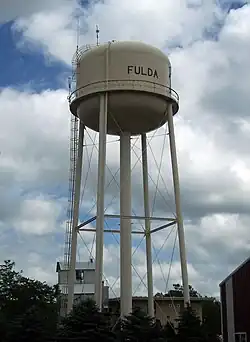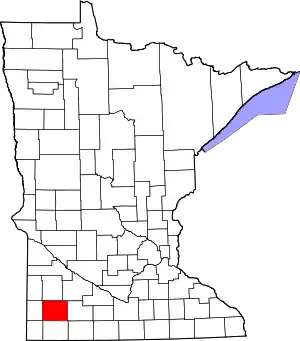Fulda, Minnesota
Fulda is a city in Murray County, Minnesota, United States. The population was 1,318 at the 2010 census.[4]
Fulda | |
|---|---|
 The watertower in Fulda | |
 | |
| Coordinates: 43°52′12″N 95°36′0″W | |
| Country | United States |
| State | Minnesota |
| County | Murray |
| Founded | 1879 |
| Government | |
| • Type | Mayor – Council |
| • Mayor | John Maertens |
| Area | |
| • Total | 1.09 sq mi (2.82 km2) |
| • Land | 1.01 sq mi (2.62 km2) |
| • Water | 0.08 sq mi (0.20 km2) 7.21% |
| Elevation | 1,532 ft (464 m) |
| Population (2020) | |
| • Total | 1,371 |
| • Density | 1,354.74/sq mi (523.17/km2) |
| Time zone | UTC-6 (CST) |
| • Summer (DST) | UTC-5 (CDT) |
| ZIP code | 56131 |
| Area code | 507 |
| FIPS code | 27-22958[2] |
| GNIS feature ID | 0643984[3] |
| Website | fuldamn |
Geography
According to the United States Census Bureau, the city has an area of 1.11 square miles (2.87 km2), of which 1.03 square miles (2.67 km2) is land and 0.08 square miles (0.21 km2) is water.[5] The city is on the north end of Fulda Lake.
U.S. Highway 59 and Minnesota State Highway 62 are two of the main routes in the city.
Neighboring communities
- Lime Creek, 2 miles (3.2 km) northeast
- Wirock, 5 miles (8.0 km) west
- Avoca, 6 miles (9.7 km) northwest
- Dundee, 6 miles (9.7 km) east
- Kinbrae, 6 miles (9.7 km) southeast
- Iona, 9 miles (14 km) northwest
- Slayton, 11 miles (18 km) northwest
- Dovray, 13 miles (21 km) north
- Reading, 13 miles (21 km) southwest
- Brewster, 13 miles (21 km) southeast
Demographics
| Census | Pop. | Note | %± |
|---|---|---|---|
| 1880 | 150 | — | |
| 1890 | 348 | 132.0% | |
| 1900 | 886 | 154.6% | |
| 1910 | 743 | −16.1% | |
| 1920 | 893 | 20.2% | |
| 1930 | 818 | −8.4% | |
| 1940 | 984 | 20.3% | |
| 1950 | 1,149 | 16.8% | |
| 1960 | 1,202 | 4.6% | |
| 1970 | 1,226 | 2.0% | |
| 1980 | 1,308 | 6.7% | |
| 1990 | 1,212 | −7.3% | |
| 2000 | 1,283 | 5.9% | |
| 2010 | 1,318 | 2.7% | |
| 2020 | 1,371 | 4.0% | |
| U.S. Decennial Census | |||
2010 census
As of the census[6] of 2010, there were 1,318 people, 566 households, and 324 families residing in the city. The population density was 1,279.6 inhabitants per square mile (494.1/km2). There were 615 housing units at an average density of 597.1 per square mile (230.5/km2). The racial makeup of the city was 91.7% White, 0.8% African American, 0.2% Native American, 4.2% Asian, 1.5% from other races, and 1.5% from two or more races. Hispanic or Latino of any race were 3.3% of the population.
There were 566 households, of which 23.3% had children under the age of 18 living with them, 47.5% were married couples living together, 6.7% had a female householder with no husband present, 3.0% had a male householder with no wife present, and 42.8% were non-families. 38.5% of all households were made up of individuals, and 22.5% had someone living alone who was 65 years of age or older. The average household size was 2.17 and the average family size was 2.90.
The median age in the city was 46.8 years. 21.8% of residents were under the age of 18; 6.3% were between the ages of 18 and 24; 19.6% were from 25 to 44; 25.9% were from 45 to 64; and 26.5% were 65 years of age or older. The gender makeup of the city was 46.1% male and 53.9% female.
2000 census
As of the census[2] of 2000, there were 1,283 people, 528 households, and 328 families residing in the city. The population density was 1,328.3 inhabitants per square mile (512.9/km2). There were 568 housing units at an average density of 588.1 per square mile (227.1/km2). The racial makeup of the city was 96.10% White, 0.08% African American, 0.55% Native American, 0.23% Asian, 2.18% from other races, and 0.86% from two or more races. Hispanic or Latino of any race were 3.27% of the population.
There were 528 households, out of which 26.5% had children under the age of 18 living with them, 54.5% were married couples living together, 4.5% had a female householder with no husband present, and 37.7% were non-families. 35.0% of all households were made up of individuals, and 24.4% had someone living alone who was 65 years of age or older. The average household size was 2.28 and the average family size was 2.94.
In the city, the population was spread out, with 24.0% under the age of 18, 4.8% from 18 to 24, 23.4% from 25 to 44, 18.2% from 45 to 64, and 29.6% who were 65 years of age or older. The median age was 44 years. For every 100 females, there were 83.0 males. For every 100 females age 18 and over, there were 80.2 males.
The median income for a household in the city was $30,000, and the median income for a family was $37,500. Males had a median income of $26,469 versus $18,750 for females. The per capita income for the city was $15,184. About 4.1% of families and 6.1% of the population were below the poverty line, including 4.7% of those under age 18 and 11.2% of those age 65 or over.
History

The city of Fulda was founded in 1881 along the Milwaukee Road primarily by German settlers, though also by Scandinavian and Irish. It was named for Fulda in Hessen, Germany.[7] Fulda is still predominantly an agricultural city.
Although the rail line was discontinued in 1980, the two-story depot building, along with a section of track, has been preserved and is listed on the National Register of Historic Places. The lower level of the depot is currently used as an antique museum and store. The other building in the city on the National Register is the former Citizens State Bank building.
Fulda has a Civil War cannon in its city park. It is a three-inch (76 mm) rifled gun and was purchased for $155 on June 25, 1892, by the Zach Taylor Post No. 42 of the Grand Army of the Republic.
Notable people
- Fulda was the birthplace of Harold Hotelling, a mathematical statistician and very influential economic theorist.
- Baseball Hall of Famer and Negro league pitcher Hilton Smith played for Fulda's semi-pro baseball team in 1949 and 1950.
- Sports columnist Patrick Reusse of the Minneapolis Star-Tribune spent his early years in Fulda.
- The Continental Co-ets, America's first touring all-girl rock & roll band, originated in Fulda in 1963.
- Ted Winter, former Minnesota House Majority Leader and longtime state representative (1987–2003) is from Fulda.
Community and culture
Local churches include First Presbyterian Church (PCUSA), Saint Gabriel's Catholic Church, Solid Rock Assembly, and Saint Paul's (LCMS) and Immanuel American (ELCA) Lutheran churches.
Local organizations include American Legion post 318, Boy Scout troop 123, Fish and Game Club, Jaycees, VFW post 9017.
Education
| Fulda High School | |
|---|---|
 The FHS Marching Band (2006) | |
| Location | |
Fulda , | |
| Information | |
| Type | Public |
| Established | 1900 |
| Principal | Michael Pagel |
| Enrollment | 124 |
| Color(s) | grey and Black |
| Team name | Coyotes |
| Rival | Murray County Central High School |
| Affiliations | Minnesota State High School League |
| Website | www.fps.mntm.org |
There are two schools in Fulda, Fulda Elementary and Fulda Secondary (also known as Fulda High School). Formerly operating in Fulda were St. Gabriel's Catholic School and Fulda Lutheran School.
Fulda Public Schools
Fulda Public Schools consists of Fulda Elementary School and Fulda Secondary School (or Fulda High School). It co-operates many sports with neighboring districts. These include football, girls' basketball, baseball, softball, track and field, and golf with Heron Lake-Okabena, known as the Heron Lake-Okabena/Fulda Coyotes, and wrestling with Murray County Central, known as the Fulda/MCC Warriors. In addition to the youth in Fulda, the school district has students from neighboring communities, including Avoca, Iona, Dundee, Kinbrae, Wilmont, and Reading.
Accomplishments
- 2006 Class A Girls Basketball Champions
- 2007 Class A Girls Basketball Champions
St. Paul's Lutheran School
Fulda's Lutheran school closed in 2018 and had been in existence since 1893.[8]
Library
Fulda Memorial Library is a member of the Plum Creek Library System. It was expanded in 2002.
The Library was founded in 1918 when it started to receive funding from the city, and was located in different businesses. On April 14, 1970, the library building was officially opened across from City Hall. In 1975 the library officially became a member of the Plum Creek Library System. In 1977 the Friends of the Library group was formed to raise funds for the library.
Politics
Fulda is in Minnesota's 7th congressional district, represented by Michelle Fischbach. At the state level, Fulda is in Senate District 21 and in House District 21A, represented by Marj Fogelman.
References
- "2020 U.S. Gazetteer Files". United States Census Bureau. Retrieved July 24, 2022.
- "U.S. Census website". United States Census Bureau. Retrieved January 31, 2008.
- "US Board on Geographic Names". United States Geological Survey. October 25, 2007. Retrieved January 31, 2008.
- "2010 Census Redistricting Data (Public Law 94-171) Summary File". American FactFinder. United States Census Bureau. Retrieved April 27, 2011.
- "US Gazetteer files 2010". United States Census Bureau. Archived from the original on July 2, 2012. Retrieved November 13, 2012.
- "U.S. Census website". United States Census Bureau. Retrieved November 13, 2012.
- Upham, Warren (1920). Minnesota Geographic Names: Their Origin and Historic Significance. Minnesota Historical Society. p. 366.
- "St Paul's Lutheran Church — Church History".
